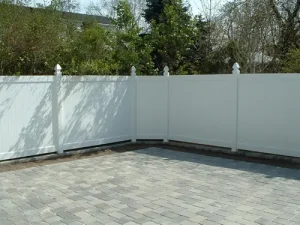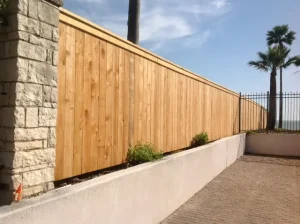![The Great Fence Debate Wood Versus Vinyl [How to Choose]](https://www.dcfence.com/wp-content/uploads/2024/04/The-Great-Fence-Debate-Wood-Versus-Vinyl-How-to-Choose-300x157.webp)
The Great Fence Debate: Wood Versus Vinyl [How to Choose?]
When it comes to enhancing the privacy, security, and aesthetic appeal of your home, few elements play as pivotal a role as your choice of

Nowadays, security is one of the most critical aspects of our lives. Whether you’re trying to protect your home or place of business, the first line of defense is often a fence. But with so many materials and styles, it can take time to determine which option is right for you.
That’s why we’re here to provide a comprehensive guide to security fence options. We’ll explore the different types of fences available, their features and benefits, and key considerations to help you make an informed decision about fortifying your space.
Security fences are essential for safeguarding all kinds of properties, from residential to commercial and industrial spaces. These fences are designed to prevent intruders, burglars, or trespassers from bypassing or breaking through the surrounding boundaries of a property. The primary objective of installing security fences is to secure and protect valuable assets or confidential information inside the premises.
Several factors, such as the location, size, and type of property, along with the level of security required, influence the selection of security fences. It is also important to consider legal considerations such as zoning laws, neighborhood restrictions, and building codes when choosing a security fence.
Traditional security fences are physical barriers to protect property or premises from unauthorized access. They have been used for centuries to deter intruders, delay their progress, and alert security personnel. In this section, we will discuss four types of traditional security fences:
Several types of security fences are available, including electric fences, anti-climbing fences, mesh panel fences, and palisade fences. Electric fences are especially effective at deterring intruders, with a mild electric shock serving as a potent warning to anyone who attempts to cross it.
Meanwhile, anti-climbing fences are designed to prevent people from climbing over them, making them particularly well-suited for high-security installations such as prisons and military bases. In addition, mesh panel fences offer a durable and versatile option that can be customized to suit a wide range of properties and needs, and palisade fences are built with tall, closely spaced vertical posts that make them nearly impenetrable.
High-tech security fence systems represent the cutting edge of perimeter security with many features and capabilities. Perimeter intrusion detection systems (PIDS) are the backbone of any modern high-tech system, providing 24/7 monitoring of the secured area. In addition, video surveillance integration offers real-time monitoring, aiding in detecting and preventing potential intrusions.
Access control systems ensure only authorized personnel can enter the secured area, while fiber optic sensing provides highly accurate detection of any attempts to penetrate the perimeter. These integrated systems offer a level of security previously thought impossible and allow for peace of mind that traditional security measures cannot provide.
Environmental considerations are becoming more and more critical when designing our surroundings. However, one aspect that is often overlooked is our impact on wildlife with fences. Fortunately, wildlife-friendly fences are gaining popularity as they allow animals to move freely and safely between habitats.
Landscaping and aesthetics also play a role in the environmental impact of our surroundings. For example, planting native species can increase biodiversity and help restore necessary habitats. Another consideration is noise reduction, which can benefit both humans and wildlife by creating a more peaceful and less stressful environment.
Assessing potential vulnerabilities and finding ways to mitigate risks are crucial while installing security fences. Whether it’s a fence around a government building or private property, identifying weak points is vital to minimize potential threats.
Property owners and security officials can have greater peace of mind knowing that their premises are better protected by taking steps to enhance the resilience of a fence, such as adding cameras or installing motion-detection sensors.
Installing a security fence around your property is a great way to enhance the safety and protection of your home or business. First, however, ensuring the fence is installed correctly is essential. It is where professional installation services come in handy. Hiring experts in security fence installation guarantees that the fence is installed to the highest standard and meets all relevant regulations and standards.
Furthermore, regular maintenance and inspections are essential to ensure the fence functions optimally. Maintenance can include cleaning, repairing, or replacing worn or damaged components. In some cases, upgrading the existing fence may also be necessary to ensure that it remains effective.
Selecting an appropriate fence is crucial for securing residential properties. There are plenty of options, but some of the best for residential properties are wrought iron and chain-link fences. Wrought iron is not only durable, but it can also add an upscale look to any home. Chain-link fences are more affordable and provide a clear view of the property, making it easier to see potential risks.
However, it’s important to balance privacy and security when selecting a fence. Adding natural barriers, such as shrubs or trees, can provide an extra layer of protection while maintaining homeowners’ privacy.
Commercial and industrial security fencing is crucial for businesses and warehouses looking to protect their assets and property. Whether it’s deterring potential trespassers, safeguarding equipment, or delineating the perimeter of a secure site, choosing the right fencing solution can make a significant difference in the overall security of your space. Beyond just securing physical property, these fences can also help protect critical infrastructure, such as power stations and transportation hubs, from vandalism or theft.
Protecting these areas becomes necessary to ensure they continue serving their purpose even during challenging times. One way of securing these areas is through fences for farms and ranches. These fences can be a physical barrier that would keep domestic animals safe and away from predators.
They also prevent the animals from wandering and help farmers control their livestock’s grazing patterns. Wildlife exclusion and protection are vital in ensuring these animals do not infringe on the farmland or threaten domesticated livestock.
Ensuring the safety and security of campuses has become a top priority for educational institutions worldwide. Installing security fences has become a popular solution to keep students, staff, and faculty safe. The need for security fences arises from the increasing crime rate, vandalism, and terrorism occurring on campuses.
While protecting valuable physical assets is a significant component of campus safety, the safety and protection of students is another critical issue that cannot be overlooked. For this reason, schools and universities must continue to take necessary measures to accomplish a secure, well-protected campus environment by installing effective security fences.
The need for security fencing is increasing as cities develop and public spaces become more crowded. Security fences aim to prevent criminal activity and offer a sense of safety to visitors. Security fencing in parks and recreational areas can protect against vandals and thieves.
Similarly, transportation infrastructure security can be enhanced by installing security fencing due to the need to secure highways and railways from damage or danger. Though security fencing may not be visually appealing, it is worth considering for ensuring public spaces remain safe.
Legal requirements and regulations are in place to ensure that the installation of security fences does not violate privacy laws. These requirements vary depending on the location and type of property. For instance, in some states, fences can be at most six feet upon obtaining a permit. Property owners must be aware of these laws and regulations and work with a professional to ensure their security measures are effective and compliant with privacy laws.
Taking security measures on your property involves considering the financial aspect, including the cost of adequate fencing. However, the expense of securing your property is an investment in your safety and well-being. While figuring out fence costs depends on various factors, such as the area’s size, materials, or additional features like gates or alarms, it’s not just about the upfront price.
Security fences can also add value to the property while lowering insurance premiums. Therefore, while estimating the costs, it’s equally important to consider the long-term benefits of securing your property.
Installing a security fence provides benefits such as deterring intruders, increasing property values, and lowering insurance premiums.
The right height for a security fence is typically determined by considering factors like the level of security needed, local regulations, and the surrounding environment.
Security fences can be customized to meet specific needs, such as incorporating additional features like gates, alarms, or surveillance systems.
Security fences generally require regular maintenance, including inspecting for damages, cleaning, and ensuring the proper functioning of integrated security systems.
Depending on the specific design and features, security fences are designed to be effective against various threats, including unauthorized access, trespassing, and vandalism.
Security fences can be integrated with other security systems like surveillance cameras, access control systems, or alarm systems to provide comprehensive protection.
The permits or approvals required for installing security fences may vary depending on local regulations and the specific location. Therefore, consulting with local authorities or building departments is vital to ensure compliance.
The lifespan of security fences can vary depending on the materials used, maintenance practices, and environmental conditions. However, security fences can typically last for many years with proper care.
Investing in the right security fence is crucial to protecting your property and ensuring the safety of those within it. But with so many options on the market, finding the perfect one can be a daunting task.
That’s where D&C Fence Co. comes in. Don’t take on this challenging task alone; let us guide you every step of the way. Contact us to learn more about how we can fortify your area and give you peace of mind.
By submitting, you agree to receive emails from Uscreen and to our privacy policy.
![The Great Fence Debate Wood Versus Vinyl [How to Choose]](https://www.dcfence.com/wp-content/uploads/2024/04/The-Great-Fence-Debate-Wood-Versus-Vinyl-How-to-Choose-300x157.webp)
When it comes to enhancing the privacy, security, and aesthetic appeal of your home, few elements play as pivotal a role as your choice of

PVC (Polyvinyl Chloride) fencing is a type of synthetic plastic fence that offers a modern alternative to traditional materials like wood and metal. Distinguished by

Wood fences are one of the most traditional and versatile types of fencing used to delineate property lines, enhance privacy, and contribute to the aesthetic
Complete the form below and a representative will contact you shortly.